Physical Address
304 North Cardinal St.
Dorchester Center, MA 02124
The NOMS framework consists of four considerations (neurological, oncological, mechanical, and systemic) and facilitates decision making for patients with metastatic spine tumors.
Conventional external beam radiation provides local tumor control in patients with radiosensitive tumors, whereas stereotactic radiosurgery (SRS) provides durable local control irrespective of tumor histology.
The Spinal Instability Neoplastic Score facilitates diagnosis of mechanical instability of the spine in patients with metastatic tumors.
Patients with spinal cord compression owing to radioresistant metastases require surgical decompression before SRS.
Separation surgery provides an efficient surgical option by providing circumferential decompression of the spinal cord and posterior instrumented stabilization without extensive vertebral body excision. Radiation is delivered after separation surgery to provide durable local control.
The early diagnosis and management of metastatic spine tumors is essential to reducing pain, preserving or improving neurological function, and improving quality of life. The three primary treatment modalities are radiation therapy (RT), surgery, and chemotherapy. The evolution of advanced radiation techniques, such as image-guided intensity-modulated radiation therapy (IG-IMRT), and noninvasive percutaneous cement augmentation and instrumented stabilization procedures have added significantly to the armamentarium in the treatment of metastatic spine tumors, as well as adding additional complexity to decision making for this patient population. An expert panel of spinal oncology specialists synthesized the available data from numerous publications detailing the indications for and outcomes of surgical and radiation treatment of spinal tumors into recommendations and guidelines. Although decision making for an individual patient remains largely based on institutional experience and the individual preferences of the treating physician, , clinical data and new decision frameworks can help guide therapy. The purpose of this chapter is to provide an overview of the evaluation and management of metastatic tumors involving the spine.
Traditionally, assessment systems such as the Tomita and Tokuhashi scoring systems have been used to guide treatment for metastatic spine tumors. The Tomita score takes into consideration the grade of malignancy, as well as visceral and bone metastases. A low score indicates a good prognosis. The Tokuhashi scoring system is useful for predicting survival and evaluates performance status, tumor histology, neurological impairment, and the numbers of bone, vertebral body, and visceral metastases. These scoring systems attempted to prognosticate survival to tailor the extent of surgical intervention. However, their exclusion of nonsurgical treatment options makes their application limited.
The NOMS decision framework comprehensively incorporates modern treatment options and consists of four fundamental considerations: neurological (N), oncological (O), mechanical (M), and systemic disease (S) ( Fig. 154.1 ). Neurological considerations include the presence of myelopathy or functional radiculopathy, as well as the degree of radiographic epidural spinal cord compression. Oncological issues primarily reflect the ability to achieve local, durable tumor control, and thus reflect the radiosensitivity and/or chemosensitivity of the tumor. Mechanical instability is a separate assessment that evaluates the spine’s ability to withstand physiological loads without developing pain, deformity, or neurological deficit. Finally, the consideration of systemic tumor burden and medical comorbidities allows the extent of the intervention to be tailored to the patient’s expected survival and ability to tolerate surgery.
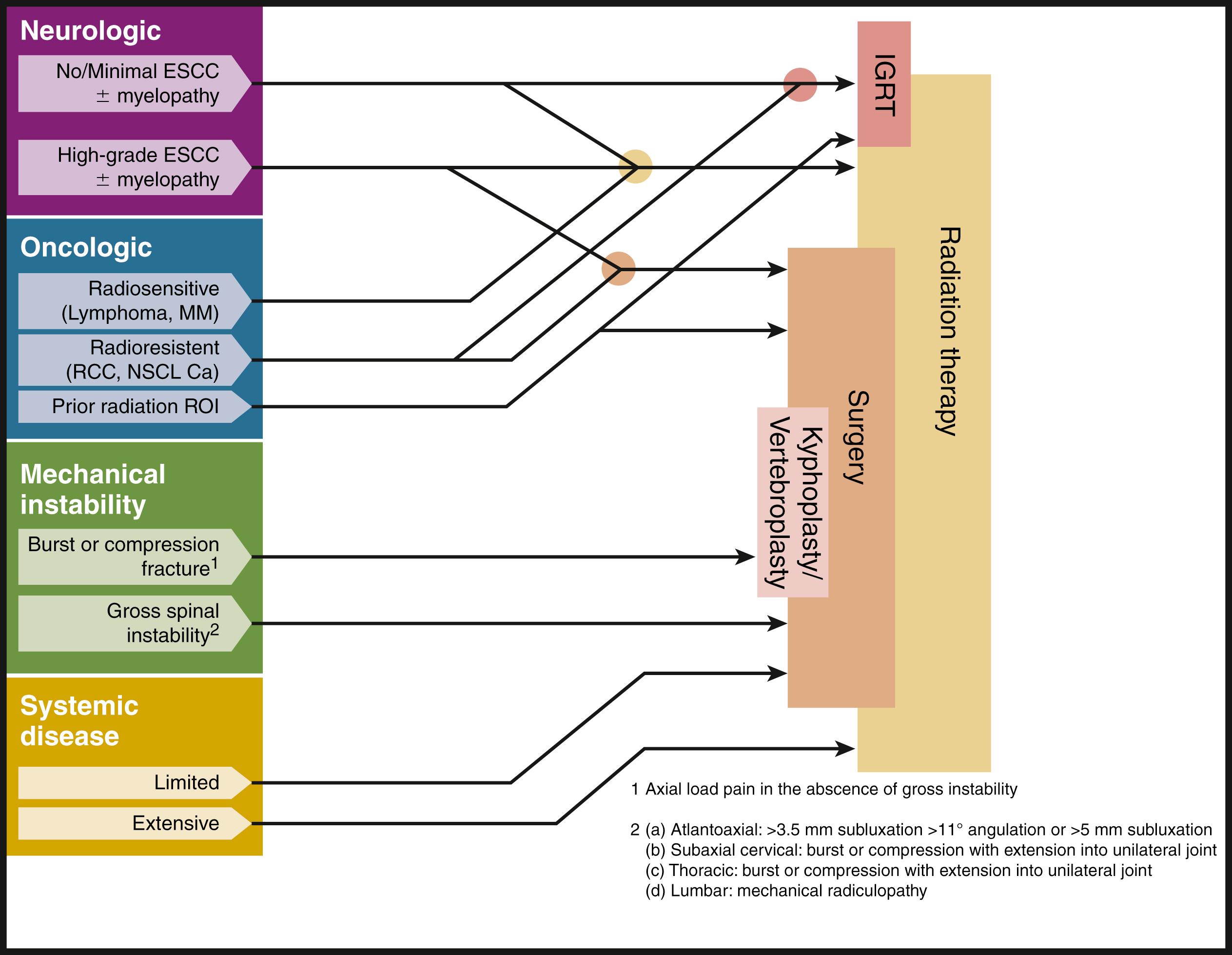
Back pain, the most common presenting symptom in patients with metastatic tumor to the bone or epidural space, often precedes the development of other neurological symptoms by weeks or months. Back pain in a cancer patient is metastatic disease until otherwise proven. Two distinct types of back pain are encountered in patients with spine tumors: biological and mechanical. Biological pain is the most common presenting symptom in metastatic cancer patients. This pain syndrome is predominantly nocturnal or early morning pain that generally improves with activity during the day. A variety of causes have been proposed, including periosteal irritation, stimulation of intraosseous nerves, and increased pressure or mass effect from tumor tissue in the bone. The likely genesis of biological pain reflects the diurnal variation in endogenous steroid secretion from the adrenal gland. At night, steroid production is reduced, resulting in increased inflammatory pain caused by cytokines released by the tumor. During the day, steroid levels rise, eliminating this biological pain. This inflammatory component of biological pain generally responds to the administration of steroids (e.g., dexamethasone 4 mg three times a day). Definitive treatment of the underlying tumor with radiation or surgery often relieves this pain. Recurrence of biological pain following treatment may be a harbinger of locally recurrent tumor.
Mechanical pain results from a structural abnormality of the spine, such as a lytic destruction of the vertebral body, resulting in instability ( Fig. 154.2 ). Clinical symptoms and radiographic correlation are important for establishing the diagnosis of instability. As opposed to biological pain, patients with mechanical instability present with pain that is worse with movement that is referable to the level of spinal involvement. For example, although pathological fractures of the atlantoaxial spine pain may present with severe pain in flexion-extension, they virtually always have a rotational component. In the subaxial cervical spine, mechanical pain is worse with flexion and extension. Patients with thoracic or thoracolumbar compression fractures often have severe pain when lying flat as opposed to sitting or standing, presumably from extension of an unstable kyphosis ( Fig. 154.3 ). The most common symptom of instability in the lumbar spine is mechanical radiculopathy. This lumbar pain syndrome results from axial load narrowing the neural foramen, causing compression of the exiting nerve root and does not typically respond to steroid or opioid medications. Patients with intractable mechanical pain are often considered strong candidates for surgery or percutaneous cement augmentation procedures ( Fig. 154.4 ).
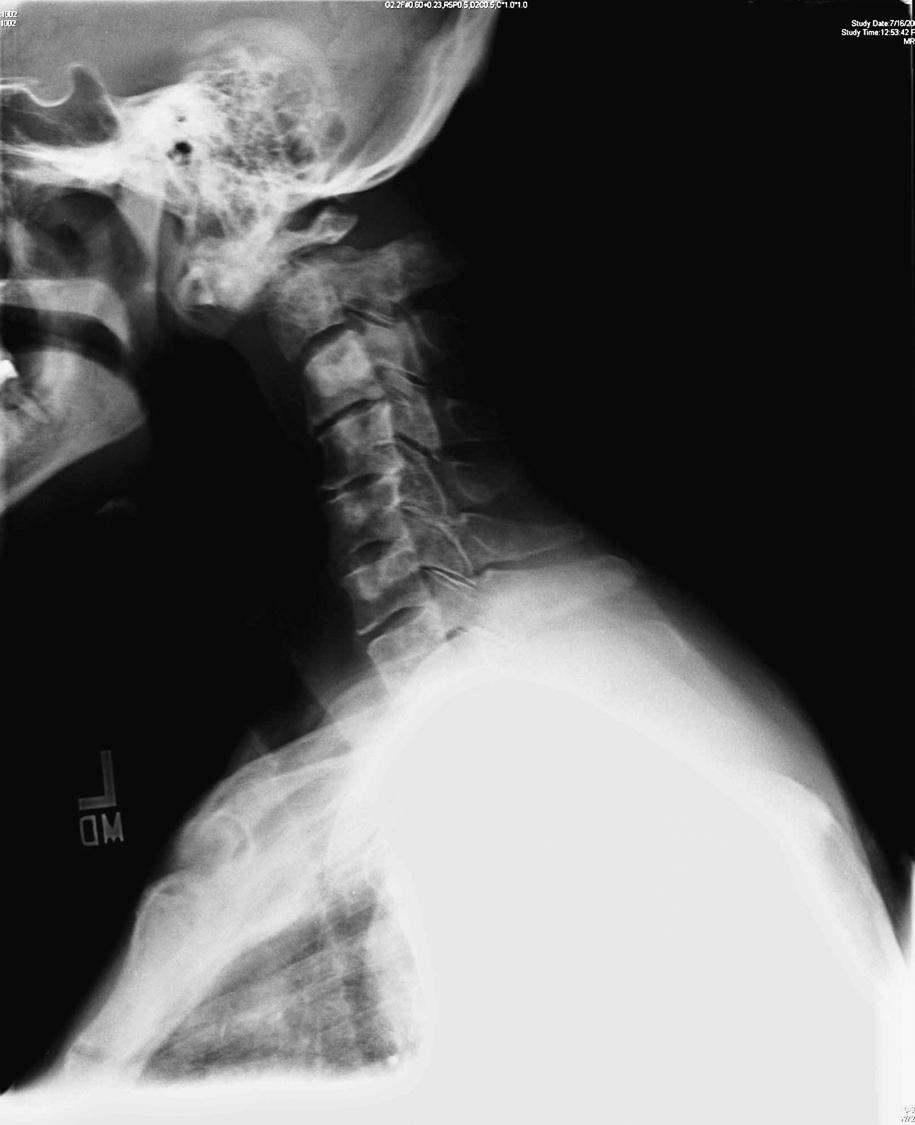
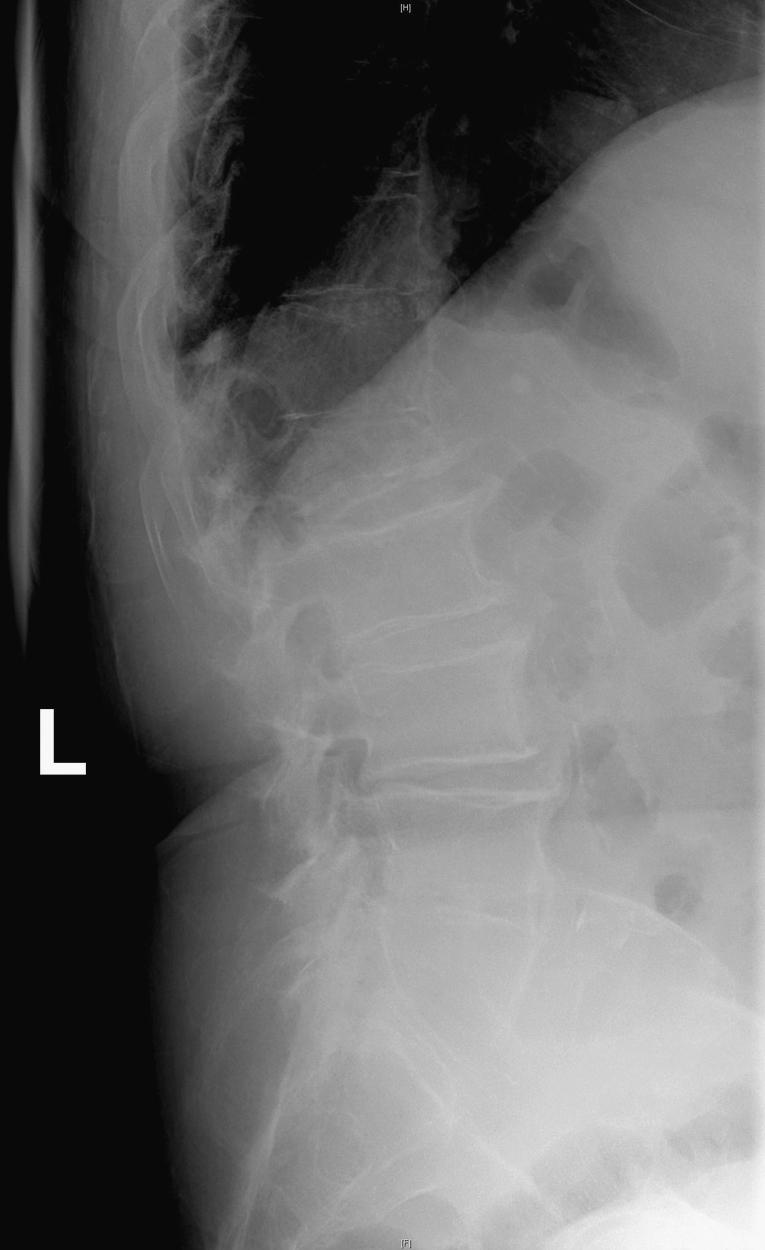

The Spinal Instability Neoplastic Score consists of six components used to facilitate the determination of spinal stability. The score ranges between 0 and 18 points, with 0 to 6 points classified as stable, 7 to 12 as potentially unstable, and 13 to 18 as unstable. Components include location, pain, bone lesion, radiographic spinal alignment, vertebral body collapse, and posterolateral element involvement. The authors validated this scoring system among spine surgeons as well as radiation oncologists. ,
Neurological signs and symptoms often begin with radiculopathy (nerve root symptoms) and are followed by the development of myelopathy (spinal cord compression). Radiculopathy in the cervical or lumbar spine can cause pain or weakness in the classic dermatomal distributions. Thoracic radiculopathy occurs as band-like pain at a segmental level, without motor deficits. Myelopathy often presents with a pain level secondary to compression of the spinothalamic tracts followed by motor loss related to corticospinal tract involvement. This may be related to the pattern of tumor arising from the vertebral body compressing the anterolateral spinal cord. Loss of proprioception from involvement of the posterior columns is often a late finding in myelopathy and results in difficulty regaining normal ambulation. Autonomic dysfunction, principally of bowel and bladder, is typically a late finding in myelopathy. The exception is compression at the level of the conus medullaris or diffuse sacral replacement, where autonomic dysfunction can be the primary finding in the absence of significant motor weakness. Neurogenic bowel and bladder symptoms are almost universally associated with perineal numbness and are most often painless. In the absence of sensory changes, one should seek other etiologies for urinary or bowel incontinence, such as narcotics, prostatic hypertrophy, or excessive laxatives.
Neurological testing should not simply focus on sensorimotor function below the level of the lesion. This is important for several reasons. First, these patients often have multiple spine lesions, and it is important to determine exactly which ones are contributing to the patient’s symptoms. In addition, it is also important to adequately rule out other causes for symptoms, such as brain metastasis or peripheral neuropathy. Any patient with facial weakness or other cranial neuropathies requires cranial imaging before surgical intervention for metastatic spine disease. In addition, focal extremity weakness with normal or decreased reflexes may be caused by plexus or peripheral nerve compression, as is seen with brachial plexus metastases. Finally, adequate documentation of the patient’s radiographic and neurological status at the time of presentation is of utmost importance to judge either response or deterioration during the course of treatment.
The evaluation of spinal patients should include a pain assessment, quantitative neurological score, general performance score, and quality of life assessment. Pain assessment can be most readily performed with a visual analog scale. The score can be converted to reflect mild (0–4), moderate (5–6), and severe (7–10) pain. The two most commonly used neurological scales include the Frankel grading system and the American Spinal Injury Association score. , Both assess motor function, with a score of “E” being normal and “A” being complete paralysis. Performance status reflects ambulation, medical comorbidities, and extent of disease. A patient may have normal motor strength but be unable to ambulate because of loss of proprioception, severe mechanical pain, lower extremity fracture, poor nutritional status, or poor pulmonary function. We have used the Eastern Cooperative Oncology Group performance status as a functional assessment. It is important to include both neurological and performance status when reviewing outcomes in cancer patients.
Metastatic tumors to the spine are classified based on numerous features, including histology, location, and pattern of tumor. The most common spine metastases are listed in Table 154.1 . These tumors are further classified into relatively radioresistant and radiosensitive groups ( Table 154.2 ), which determines which type of radiation the patients require to achieve local tumor control. Tumors may further be divided by the level and extent of spinal element involvement (e.g., vertebral body, posterior element, or circumferential) and degree of epidural compression (see below). Thorough radiographic imaging is essential for treatment decisions.
| Primary Site | % of all spine metastases ( n = 11,884) |
|---|---|
| Breast | 30.2 |
| Lung | 20.3 |
| Blood | 10.2 |
| Prostate | 9.6 |
| Urinary tract | 4.0 |
| Skin | 3.1 |
| Unknown primary | 2.9 |
| Colon | 1.6 |
| Other | 18.1 |
| Sensitivity | Tumor Histology |
|---|---|
| High | Lymphoma |
| Myeloma | |
| Intermediate | Breast |
| Prostate | |
| Low | Sarcoma |
| Renal cell | |
| Lung | |
| Colon |
Advances in imaging have improved the sensitivity of detecting spinal metastases and the specificity of differentiating other processes that involve the spine. Magnetic resonance imaging (MRI) has revolutionized assessment of metastatic spine tumors, but many imaging modalities play a role in evaluating patients with metastatic spinal tumor, including plain radiographs, bone scan, computed tomography (CT) scan, myelogram, and positron emission tomography (PET). The goal of imaging is to be 100% sensitive and specific in identifying tumor, giving precise anatomic detail, identifying distant metastases, and showing recurrent tumor following the placement of instrumentation. No single imaging modality accomplishes all of these goals, but understanding the advantages and disadvantages of different imaging modalities will assist the clinician with patient screening and treatment planning.
Plain radiographs are often ordered as the first test to evaluate a patient with cancer who has new onset back pain, but they are relatively poor screening tests for metastases ( Fig. 154.5 ). Visualization of a radiolucent defect on plain radiographs typically requires at least 50% destruction of the vertebral body. Additionally, metastatic tumor often infiltrates the bone marrow of the vertebral body without destroying the cortical bone. Compression and burst fractures are readily identified. Plain radiographs can identify sagittal (kyphosis) and coronal (scoliosis) plane deformities in a weightbearing state, whereas spinal deformities imaged in a supine position by MRI or CT scans may be reduced and thus remain undetected. Dynamic flexion and extension films may be used to detect instability, although in our experience they are rarely necessary and may put the patient at risk for progressive spinal cord injury. Following surgery, plain films are the best imaging modality for assessing spinal alignment and structural integrity of the instrumentation.
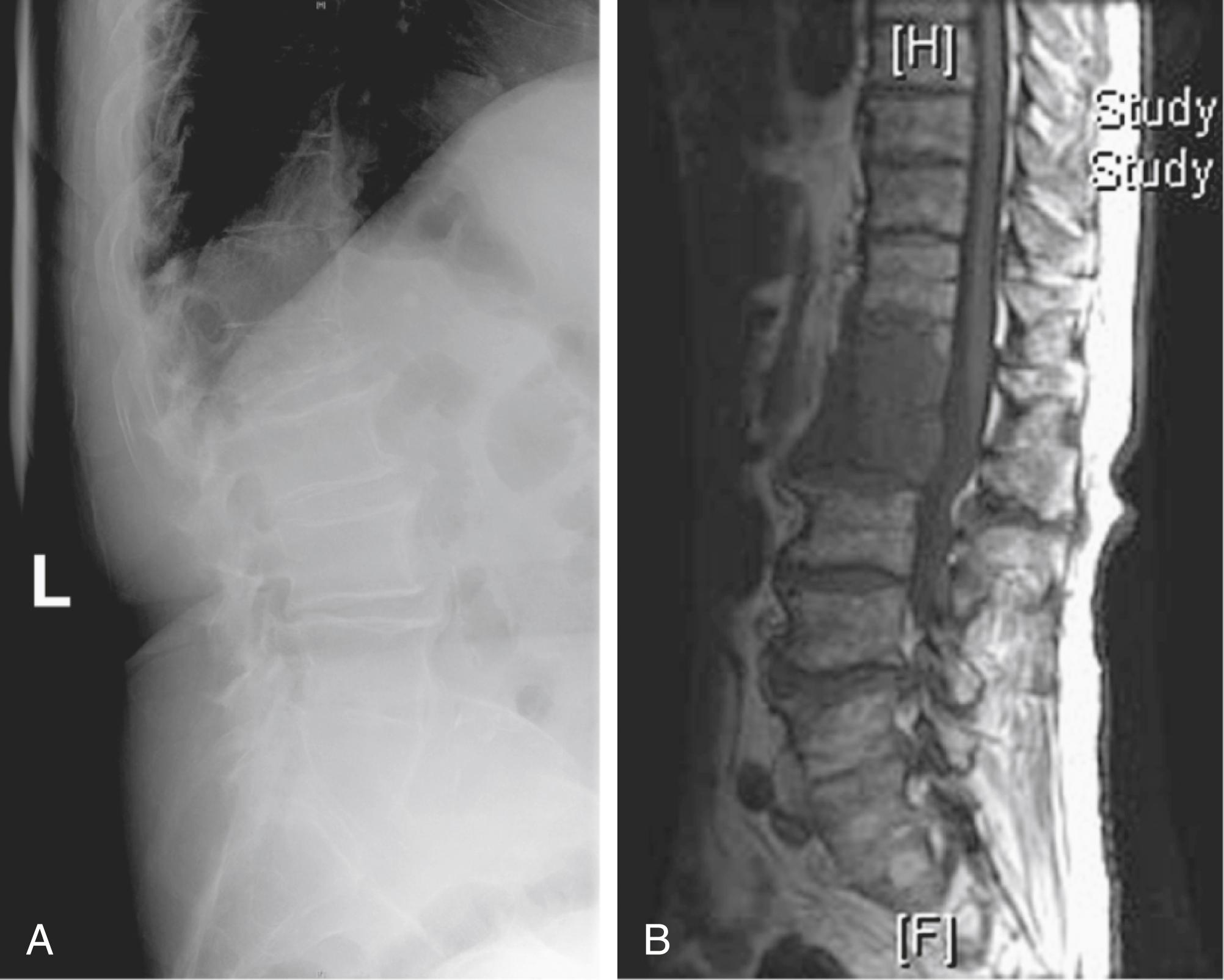
Bone scans ( 99m technetium–methyl diphosphonate) are more sensitive than plain radiographs for detecting spinal metastases ( Fig. 154.6 ). The advantage of a bone scan is the ability to screen the entire skeleton with a single image. Patients with spinal tumors often have other bone involvement that may be causing symptoms or require intervention. For example, a patient with L2 vertebral body disease causing nerve root compression may have a concomitant, symptomatic tumor in the pelvis, hip, or femur. However, bone scans rely on an osteoblastic reaction or bone deposition to detect spinal metastases, so rapidly progressive, destructive tumors may not be detected. , Bone scans are relatively insensitive for multiple myeloma and tumors confined to the bone marrow and have a low specificity for tumor. Fractures, degenerative disease, and benign disorders of the spine (Schmorl nodes, hemangioma) all may be positive. Additionally, paraspinal tumors that enter the epidural space through the neural foramen can result in back pain and progressive neurological symptoms that often are not detected on bone scan. In a review by Avrahami et al., 21 out of 40 patients (52%) with previously diagnosed tumor and symptoms referable to the spine had a negative CT and bone scan, but tumor was seen on MRI. Frank et al. reviewed a series of 95 patients in which 28% had a negative bone scan with MRI scan showing tumor, and a discordance rate between the two imaging modalities of 31%.
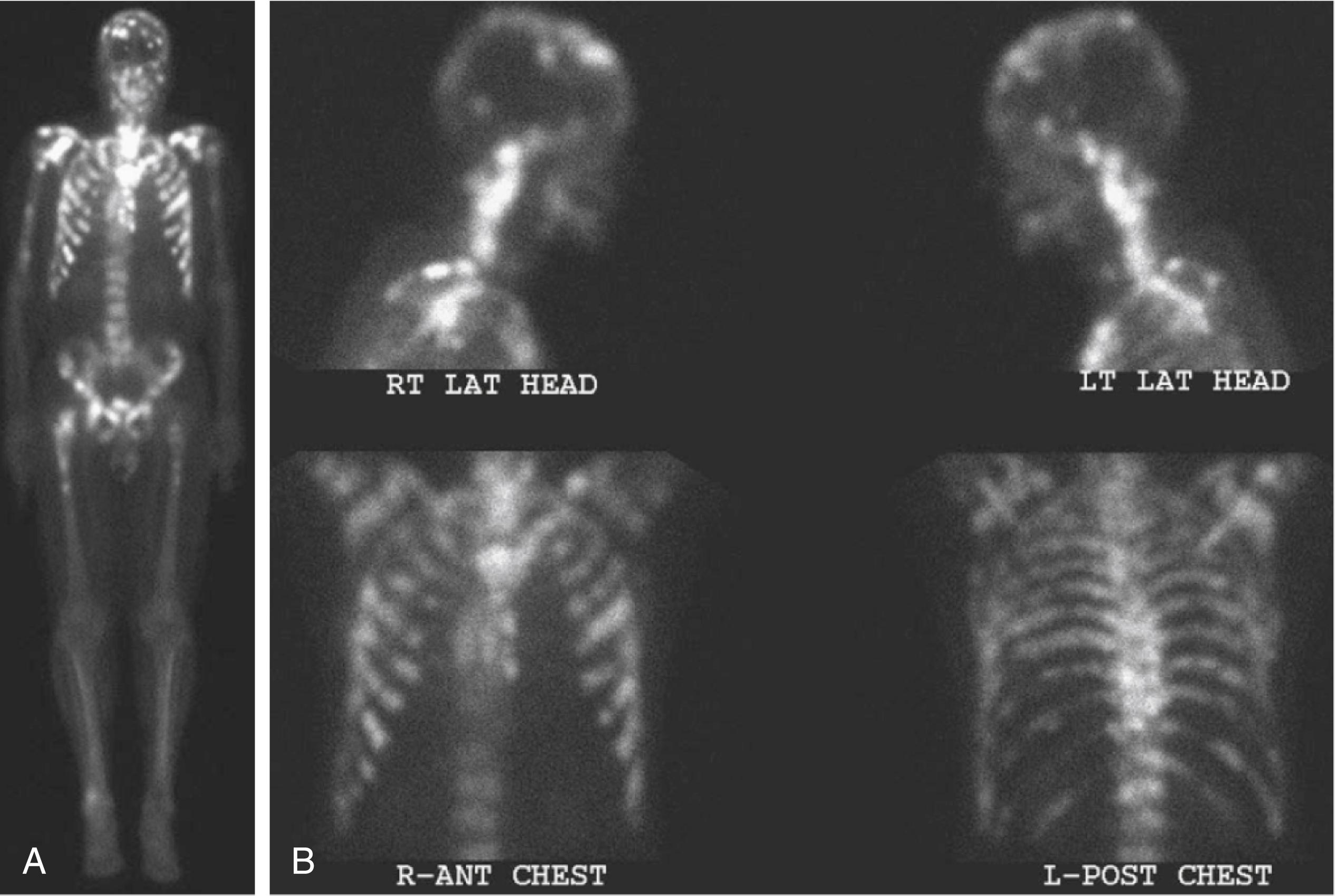
Until MRI became widely available, myelogram and CT scan were the best diagnostic modalities for assessing acute spinal cord compression. Risks associated with myelography, including acute neurological decompensation in patients with high-grade blocks, have diminished its role. , CT continues to be useful both for assessing the degree of bone destruction and assessing when bone rather than tumor is causing spinal cord compression. For patients who have had spinal reconstruction with placement of metallic instrumentation, including titanium, it may be difficult to obtain accurate images of the spinal canal with MRI, and CT myelogram may be helpful for ruling out recurrent epidural disease and spinal cord compression ( Fig. 154.7 ). Myelography and postmyelogram CT images continue to be used for imaging these patients. Also, CT myelograms are currently used for radiosurgery treatment planning to specifically identify the location of the spinal cord or cauda equina.
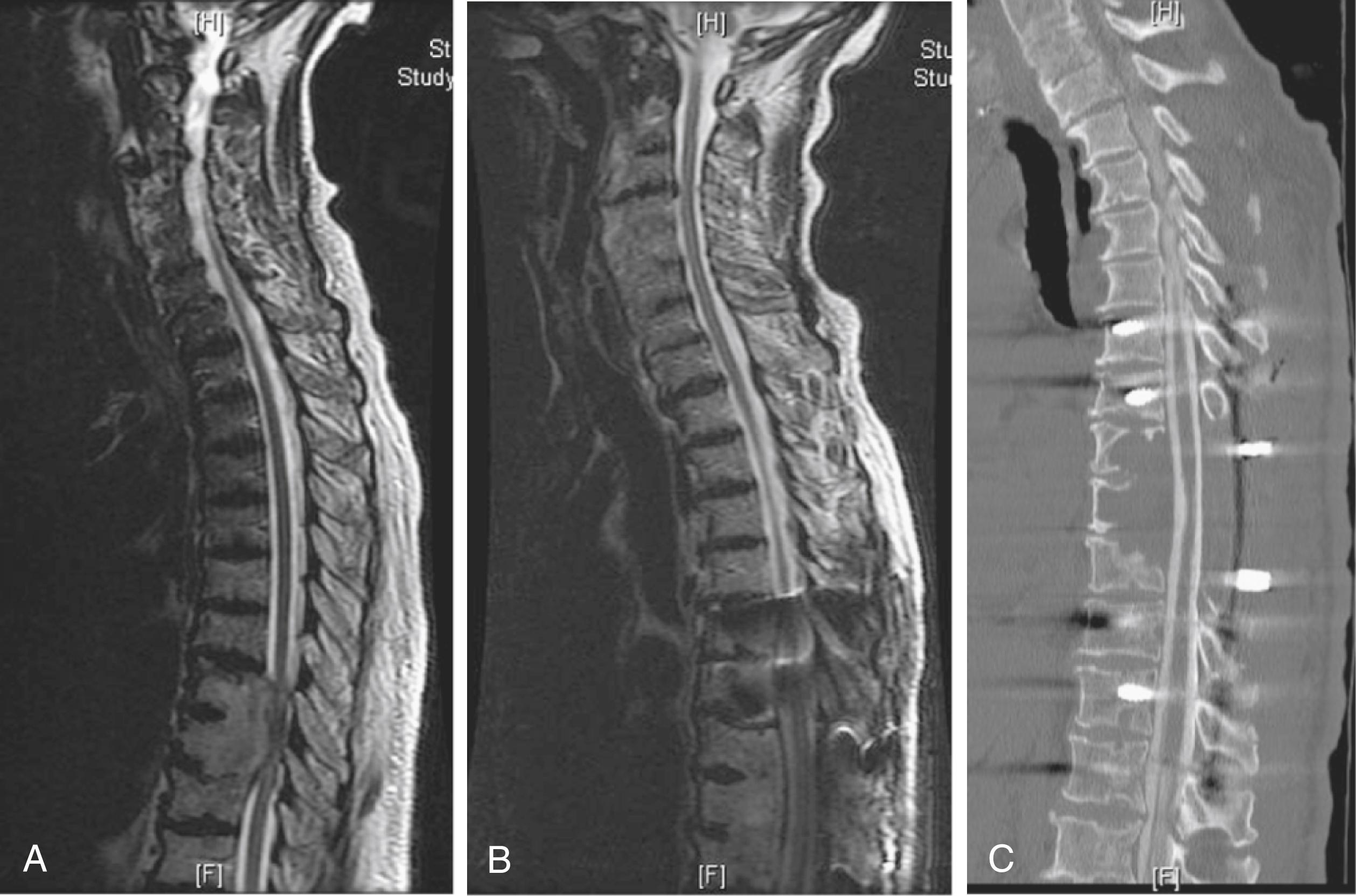
MRI is the most sensitive and specific modality for imaging spinal metastases. Sagittal screening images of the entire spine reveal bone, epidural, and paraspinal tumor. The extent and degree of spinal cord compression can be readily appreciated, especially on T2-weighted images ( Table 154.3 ). Hybrid scans of the brachial or lumbosacral plexus may reveal tumor in patients with extremity weakness that is not entirely related to spinal cord or root involvement. Leptomeningeal metastases and intradural metastases are often well-visualized, but require the use of contrast agents (gadolinium-labeled diethylenetriaminepentaacetic acid) ( Fig. 154.8 ).
| Grade a | Description |
|---|---|
| 0 | No subarachnoid space compression |
| 1 | Subarachnoid space partially obliterated without spinal cord compression |
| 2 | Subarachnoid space partially obliterated with spinal cord compression |
| 3 | Subarachnoid space completely obliterated with cord compression |
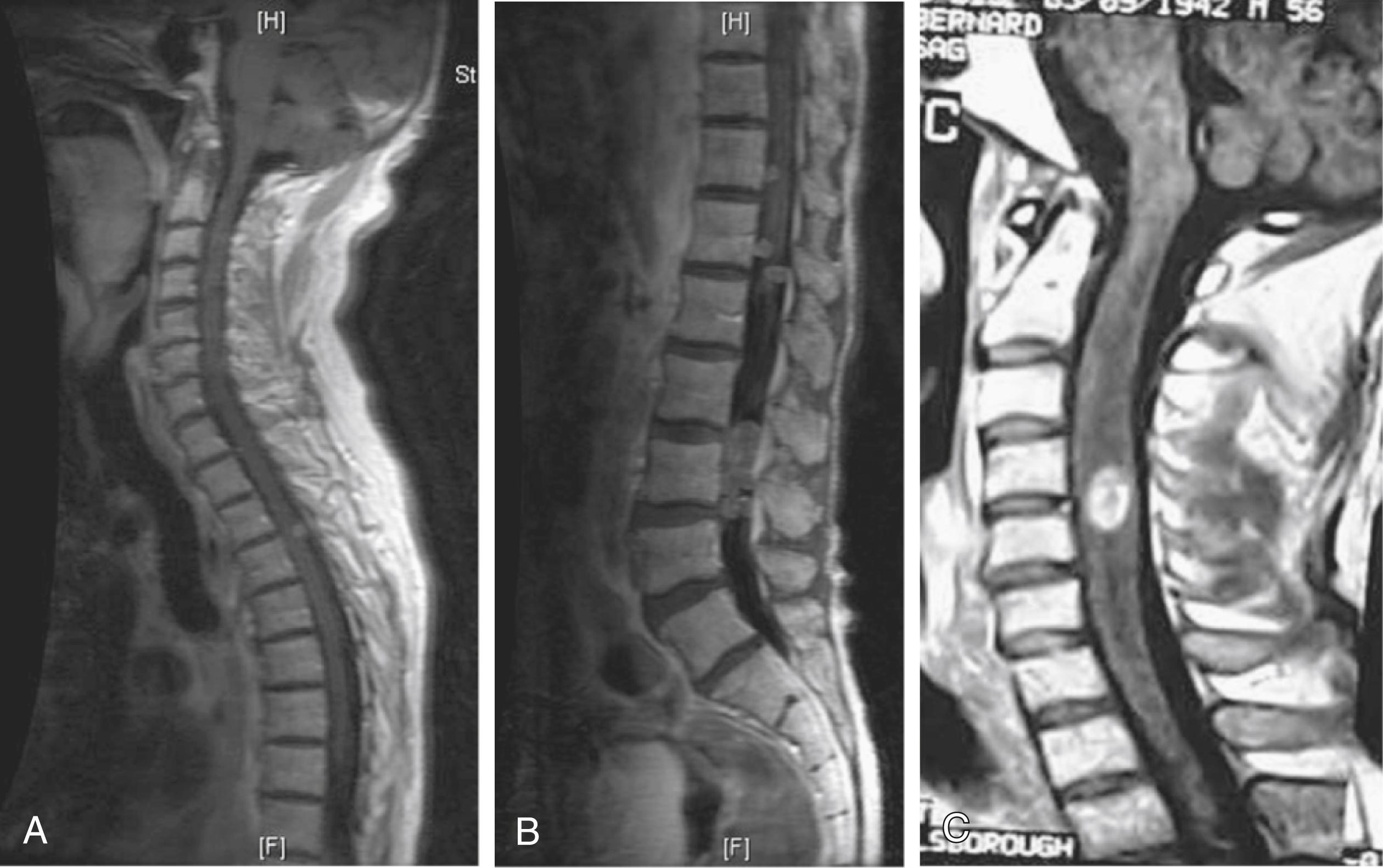
Common imaging sequences used to evaluate spinal metastases are T1-weighted and T2-weighted MRI. Tumor on a T1-weighted image is hypointense relative to the normal marrow signal ( Fig. 154.9A ) and typically enhances after administration of gadolinium (see Fig. 154.9B ). The ports from prior spinal radiation can be discerned on T1-weighted images as hyperintense signal change and may assist in making acute therapeutic decisions when radiation port films are not available. Tumor is hyperintense relative to marrow on standard T2-weighted imaging and produces a myelogram effect, with cerebrospinal fluid (CSF) appearing hyperintense (see Fig. 154.9C ). Unfortunately, using the recently developed timesaving fast spin echo, T2 techniques may decrease tumor conspicuity. This decreased conspicuity can be compensated for using short tau inversion recovery (STIR) techniques. STIR images show enhanced contrast between the lipid marrow (hypointense) and tumor (hyperintense) (see Fig. 154.9D ). They may be the most sensitive screening modality for tumor, but give less anatomic detail than standard T1 or fast spin echo T2 images. Because of the high rate of multiple noncontiguous lesions, we suggest screening the entire spine. At our institution, a screening assessment of the entire spine is obtained specifically evaluating the T1-weighted and T2-STIR images. The degree of compression is based on the axial T2-and/or axial T1-weighted postcontrast images.
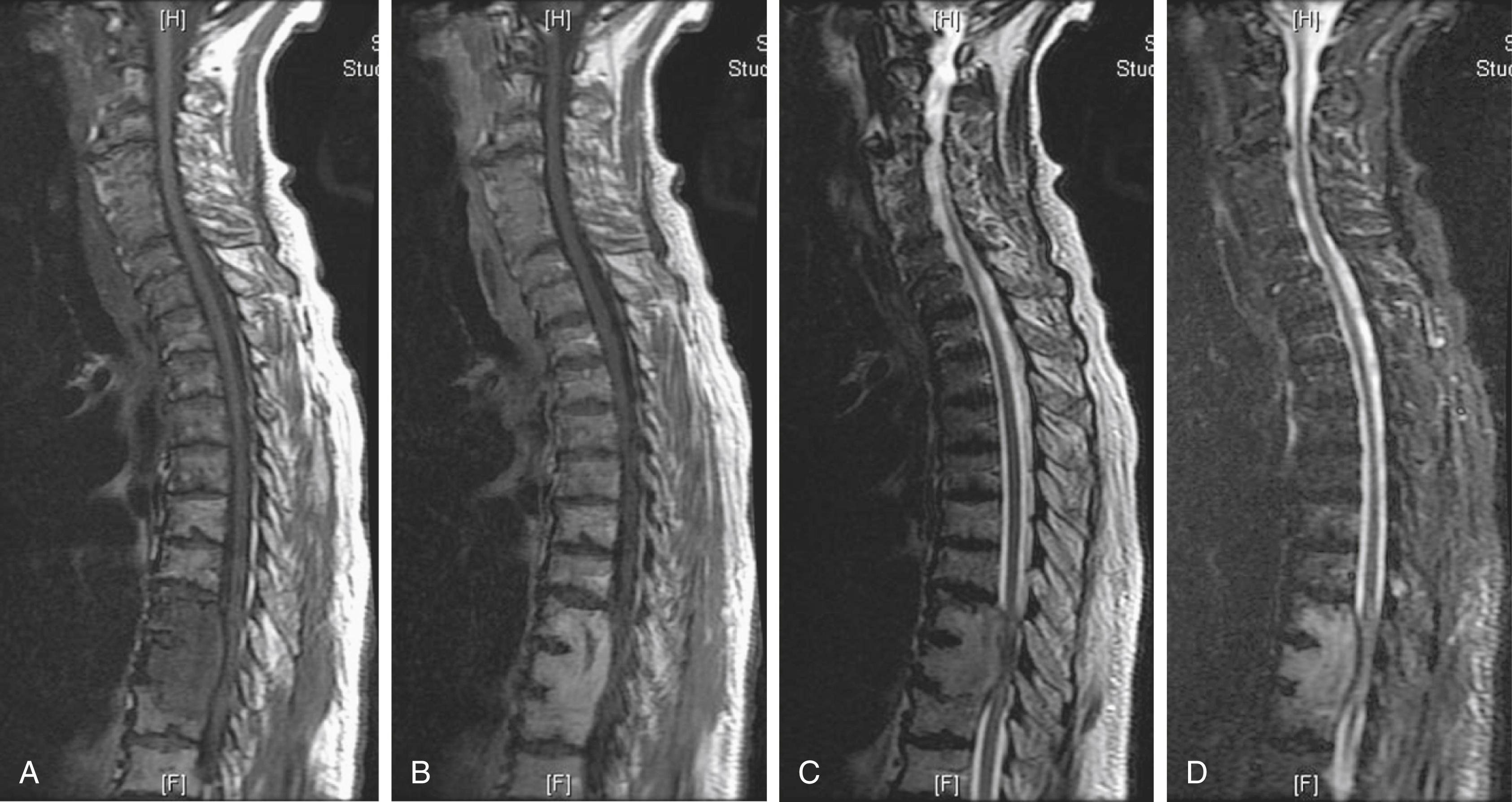
The conversion of spine tumor assessment from CT myelogram to MRI left a void in describing the degree of spinal cord compression. For instance, no correlate existed on MRI for a complete myelographic block. NOMS decision making is often made based on the neurological assessment of the degree of spinal cord compression in combination with relative radioresistance of the tumor. The Epidural Spinal Cord Compression (ESCC) score was developed to provide a common language for description of the degree of spinal cord compression, with best inter- and intrarelater reliability noted using T2-weighted images compared to T1-weighted pre- or postcontrast images in the assessment of spinal cord compression. The ESCC grading system assesses tumors on T2-weighted axial images and assigns a score from 0 to 3. Grade 0 indicates tumor within bone only, without any involvement of the epidural space. Grade 1 is subarachnoid space impingement by tumor extending from the bone, but no compression or deformation of the spinal cord. For radiosurgery planning purposes, ESCC grade 1 was subdivided into 1a (epidural abutment), 1b (epidural impingement), or 1c (epidural impingement with spinal cord abutment). Grade 2 indicates spinal cord compression or displacement, but spinal fluid is still visualized at the level of compression. Grade 3 is spinal cord compression with obliteration of all CSF space at the level of cord compression or circumferential tumor. Grade 3 is the MRI radiographic equivalent of a complete block on myelogram ( Fig. 154.10 and Table 154.3 ).
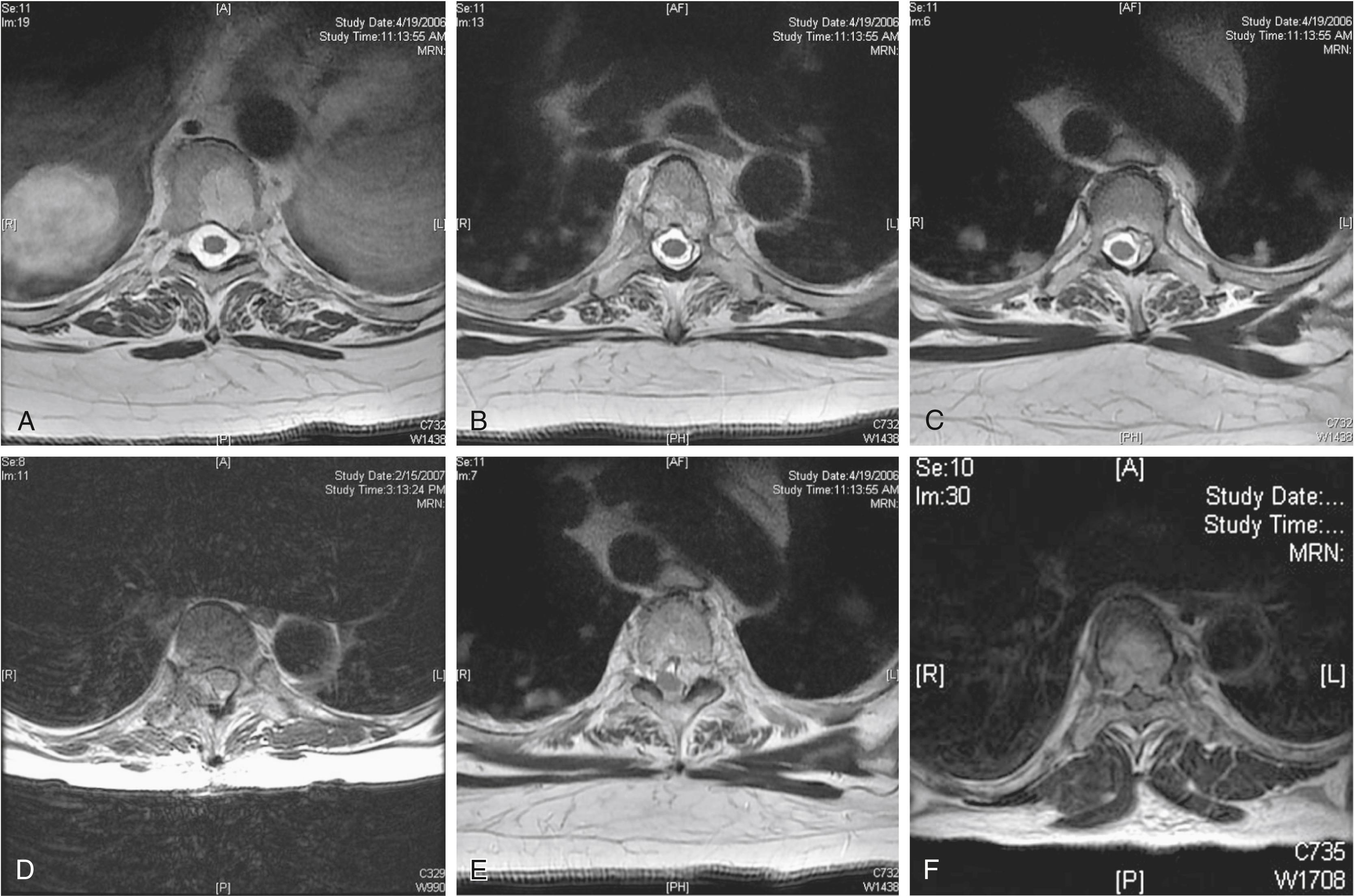
Although MRI is an excellent screening tool for metastatic tumor spread to bone, differentiating tumor from osteomyelitis, osteoporotic compression fractures, and previously treated tumor may be difficult. The T1 and T2 signal characteristics are similar in all of these conditions. Osteomyelitis is more likely to cause changes in the end plate and disc space, whereas tumor rarely, if ever, involves the disc space. Based on these imaging characteristics, osteomyelitis can be differentiated from tumor with 97% accuracy. Unfortunately, patients with tumor may secondarily become infected, rendering the imaging patterns unreliable in these situations.
Osteoporotic compression fractures are extremely common in the cancer population and have been differentiated from pathological fractures with 94% accuracy based on T1-weighted imaging characteristics. Osteoporotic fractures are more commonly thoracic, have band-like abnormality, and do not involve the pedicle or have contour abnormality. Pathological fractures show homogeneously decreased T1 signal and have convex vertebral contours. Pathological fractures may involve the pedicles.
Oncologists often rely on imaging changes to determine the efficacy of treatment; however, response to RT or chemotherapy is difficult to assess in bone tumors because of the lack of signal change on MRI. On T1-weighted images, both treated and viable tumors appear hypointense relative to normal marrow signal. In a study of breast cancer patients, only 3% had a reduction in the volume or number of vertebral bodies involved on imaging, and there was no correlation between changes in signal intensity and clinical response to therapy. In a palliative situation, clinical response to therapy (resolution of tumor-related pain) may suffice despite the absence of radiographic change. Therapeutic decisions for some metastatic tumors (e.g., Ewing sarcoma, neuroblastoma, and seminoma) rely on differentiating viable from necrotic tumor. Traditional MRI sequences do not change significantly post treatment. Recently, dynamic contrast-enhanced MRI (DCE-MRI) has shown promise in predicting and monitoring tumor response to radiation. Early reports indicate that perfusion changes in DCE-MRI closely correlate with tumor response to therapy and predict vascularity on angiography.
Recent work has explored the use of 2-[F-18] flouro-2-deoxy-D-glucose (FDG-PET) for differentiating osteoporotic or traumatic fractures from pathological compression fracture and to determine viability of previously treated bone tumors. Additionally, on T1-weighted images, bone edema may appear hypointense, similar to tumor signal, and FDG-PET may be useful in directing the biopsy to a specific hypermetabolic site in the vertebral body, thereby increasing the chance of successfully making a diagnosis. Laufer et al. reviewed 82 patients with hematological and solid tumor malignancies. All patients underwent biopsy within 6 weeks of their PET scan. The mean standardized uptake value (SUV) values were 7.1 for malignant tumors compared to 2.1 for benign lesions ( P < .02). A 100% concordance was identified with an SUV cutoff of 2 in solid tumor malignancies with lytic or mixed lytic sclerotic bone involvement. Sclerotic bone lesions often have low SUVs secondary to the paucity of tumor cells, and PET is less predictive in differentiating osteoblastic tumors from benign pathology. Similar work relating SUV values to the presence of tumor found a threshold cutoff of 2.5 that predicted tumor. Improved diagnostic accuracy can be achieved by combining PET with CT, as 18(F)-FDG PET/CT has a greater specificity for detecting spine metastases than either 18(F)-FDG PET or CT alone ( Fig. 154.11 ). Other radionuclide scans may be helpful for screening specific tumor types, including I scans for papillary thyroid cancer, metaiodobenzylguanidine scans for neuroblastoma, and somatostatin scans for neuroendocrine tumors.
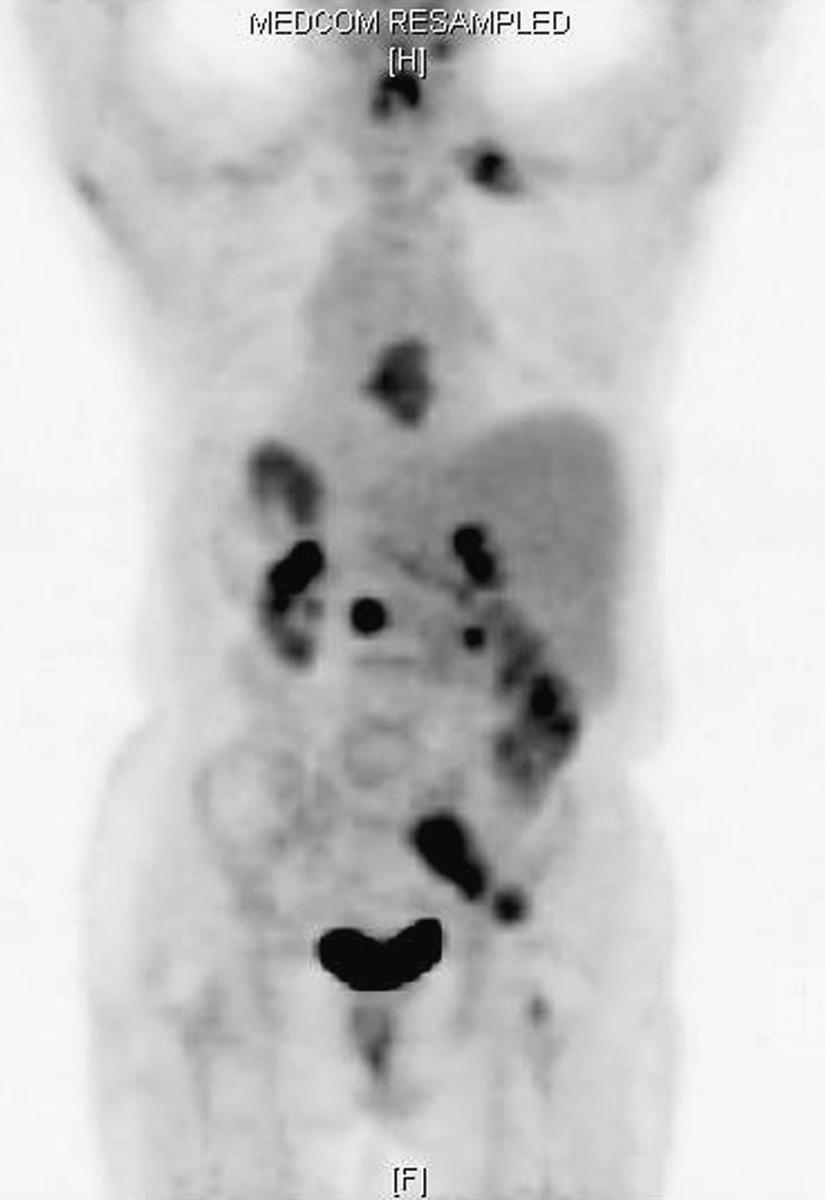
Cancer patients are prone to numerous metabolic and physiological abnormalities either as the result of their disease process or as a side effect of previous treatments. Therefore, assessment for many of these abnormalities must be performed before considering treatment. Hypercalcemia occurs in approximately 10% to 20% of all cancer patients, with lung and breast tumors being the most common primaries. The pathophysiological abnormalities that lead to this condition are believed to be secondary to the multifactorial effects of increased bone turnover and increased calcium reabsorption in the proximal renal tubules. However, immobilization and dehydration have also been shown to be contributing factors, especially in patients with end stage disease. These homeostatic abnormalities are now thought to be the result of secretion of parathyroid hormone–related protein, as well as secretion of cytokines such as tumor growth factor (TGF)-β, interluekin (IL)-1, and tumor necrosis factor (TNF). Hypercalcemia is commonly treated with intravenous fluid rehydration and bisphosphonate administration; left untreated, it can result in cardiac or kidney dysfunction, and even death in extreme cases.
Coagulation abnormalities also occur commonly in this patient population. This can be attributed to their cancer diagnosis, as well as to an association with neurosurgical procedures. Coagulopathies can result from metastatic tumor spread to the liver, or more commonly from the toxic side effects of chemotherapeutic agents. In addition, the frequent blood transfusions that some of these patients receive may result in antiplatelet antibodies that may resist replacement transfusions. Thrombocytopenia may result from diffuse bone marrow replacement or wide-field irradiation, but commonly results from chemotherapy or common medications, such as heparin. A blood panel for heparin-induced thrombocytopenia is sent for patients taking heparin or heparin analogues who are thrombocytopenic, and the medication should be stopped. Treatment for coagulopathies depends primarily on the underlying cause.
Diminished pulmonary reserve is another abnormality that is encountered quite commonly in patients with metastatic tumors. For example, patients undergoing thoracotomy for the treatment of lung cancer may be left with marginal reserve capacity. This is also seen as a result of multiple lung metastases, interstitial pulmonary fibrosis secondary to chemotherapy, pleural effusion, and the consequences of smoking. At our institution, all patients obtain a chest x-ray, and any patients with prior thoracotomy, any previously mentioned risk factor, or a history of dyspnea are evaluated with preoperative pulmonary function tests.
Cancer patients are also at an increased risk for developing deep venous thrombosis (DVT). The etiology is thought to be multifactorial and not simply a result of immobility. Many solid tumors release cytokines and other tissue factors that have procoagulant effects. We have found perioperative prophylaxis with pneumatic compression boots and pharmacological prophylaxis to be helpful, but not foolproof, in decreasing the rate of postoperative DVT. The majority of cancer patients undergoing spinal surgery have limited mobility, therefore we routinely perform Doppler ultrasound screening before surgery. Preoperative screening of patients revealed an overall 9.5% incidence of DVT, with a 24.4% incidence among nonambulatory patients. When a DVT is identified preoperatively, it is managed with inferior vena cava filter placement. Postoperatively, DVTs are treated with either inferior vena cava filters or anticoagulation. Leon et al. showed a benefit of prophylactic filter placement for patients undergoing major spine surgery. Risk factors for pulmonary embolism included malignancy, prior history of thromboembolism, being bedridden for longer than 2 weeks before surgery, undergoing staged or multilevel procedures, and undergoing prolonged surgery (>8 hours). Consideration for placement of removable vena cava filters should be given to any tumor patient with a significant paresis or plegia who will need to be intermittently discontinued from full-dose anticoagulation. Postoperatively, DVTs are treated with either inferior vena cava filters or anticoagulation.
Many patients treated for spinal cord compression are also undergoing active chemotherapeutic treatment either for their primary disease or to control metastatic disease. A major concern is that many of these agents affect blood counts for several days after their administration. This may place patients at risk for neutropenia, anemia, or thrombocytopenia, all of which can have devastating consequences if not considered preoperatively. Furthermore, modern targeted systemic therapies, particularly vascular endothelial growth factor inhibitors, significantly impair wound healing, placing patients at high risk for incisional complications.
The presence of distant metastases to extraspinal sites and active disease at the primary site are not contraindications to spine surgery, but recognizing the extent of disease is important for decision making. In patients with diffusely metastatic or rapidly progressive tumor, options such as radiation may be more appropriate. However, we often determine the appropriateness of surgical interventions based more on the patient’s overall medical condition as opposed to tumor load. Even in cases with limited life expectancy (3–6 months), decompression and stabilization may help preserve neurological function, and thus quality of life, as well as palliate pain symptoms with an acceptable level of morbidity.
Tumor staging is usually performed in conjunction with the primary oncologists who have a better appreciation of the patient’s disease in terms of overall aggressiveness, pace of progression, and future systemic therapy options. This workup is typically performed with radiographic studies, including CT scans with and without contrast of the chest, abdomen, and pelvis. PET-CT scans are more commonly being used to screen patients. Serum markers can also be used to screen for the presence or progression of tumors, such as prostate specific antigen (prostate carcinoma), CA-125 (breast carcinoma), and carcinoembryonic antigen (colon carcinoma). These markers are remarkably sensitive and may be an early indicator of tumor recurrence. In prostate carcinoma with spine involvement, the prostate-specific antigen often serves as a marker for tumor recurrence well in advance of scheduled surveillance MRI scans.
The adequate control of cancer-related and postoperative pain can be very challenging in this population. A significant number of these patients may have chronic pain syndromes and require large doses of narcotics, typically in the form of delayed release oral or transdermal preparations. , This makes postoperative pain control difficult because of tolerance to these agents. At our institution, all patients receive narcotics via patient-controlled analgesia (morphine, fentanyl, or dilaudid) postoperatively, with a goal to transition to oral or transdermal medications on the first postoperative day. It is often helpful to obtain input from pain management specialists for those patients with significant preoperative symptoms or high dose requirements.
Become a Clinical Tree membership for Full access and enjoy Unlimited articles
If you are a member. Log in here